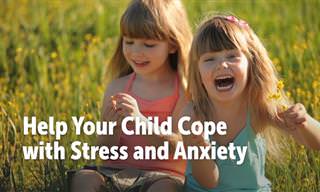



7 Ways to Inspire Your Children to Do Chores
These tips will help you encourage your children to help out around the house and teach them the importance of teamwork.

These 5 Tips Will Help Your Child Cope With Anxiety
Here are some ways to help your children manage their stress levels that will make their, and your lives much easier.

How Should Your Child Act With Strangers? Read This!
Take steps to ensure your child's safety with this guide.
 9:19
9:19
Parenting Tips: How to Put a 2 Year Old to Bed
This video tutorial offers practical solutions tailored for your 2 year old's bedtime.

For Healthy Looking Skin, Do You Need Collagen?
If you've got saggy, wrinkly skin, here's how you can increase your collagen intake.

7 Ways Persistent Coughing Hurts Our Body
Don't let a cough go unnoticed. This is how it can harm your body.

How to Stop a Crying Baby in Just a Few Seconds
There is nothing worse than a baby that just won't stop crying. Well, thanks to Dr. Hamilton, this problem could now be a thing of the past!

They May Drive You Crazy, But Family is Family!
Family can drive you crazy but at the end of the day you can't help but love them. Here are some beautiful and funny quotes and pictures to make your day.

These 40 Compliments Will Have a Lasting Effect on a Child
Every child should hear these words every once in a while.

This Mother's Letter to Her Daughter Touched Me Deeply
There is nothing quite like a mother's love for her daughter, as this heartbreaking letter reveals. Prepare to be moved.
 2:14
2:14
As a Baby Grows, THIS is What It Will See...
It's no secret that babies see the world differently than the rest of us do, and this video will show you just what their visual development looks like.

Why Children Suck Their Fingers and How to Make It Stop
To aid in understanding and addressing finger sucking, this article discusses why it may happen and how to stop the behavior.

How to Raise Happy Children: 10 Scientific Steps!
The most important thing for kids' success is their happiness, and these 10 top tips for getting your kids and grandkids happy are backed by science!

8 Signs It's Time to Sever Ties From a Family Member
Sometimes, it’s important to sever ties with a family member who has been nothing but toxic to you.

Guide: What to Feed a Baby at Every Age
Not all solid foods are suitable for every stage, which is why we have created a guide to help you feed your baby according to their age.

If a Child Lives with Praise, This Is What He'll Learn...
How should we go about raising our children to be strong, independent and certain of themselves?

11 Marriage Misconceptions We Should Forget About
these 11 myths demonstrate why a perfect marriage is unrealistic.

WARNING: Before You Buy a Rotisserie Chicken, Read This
Are rotisserie chickens bad for our health or are they just as healthy as regular chicken?

This Short Tale Reminds Us of a Person’s True Worth...
A short story that will remind you what a person's true worth is...

Couples Passionate About Each Other Practice These Rituals
It's amazing to think what miraculous things can happen between a couple when new positive, behavior patterns are developed.

This Devoted Dad Has Some Words to Share....
Michael Mitchell is a devoted American father who collects tips from various fathers about raising kids, and these are some of his most interesting!

8 Things You’re Doing That Are Spoiling Your Child
The desire to help our children and keep them happy all the time may make them spoiled, so avoid it by following these 8 tips!

The Naked Truth Behind Why Men Don't Listen to Women
Have a good look at the 10 biggest reasons why men don't always appear to listen to the women in their lives.

For a Divorce-Proof Marriage These Tips Are All You Need
Read these words of advice carefully, and write them on your heart!

There's a Reason Why Women are Sensitive...
When a woman cries, there's always a deeper reason behind it. Sometimes she just needs to let go what's inside of her. See this beautiful story.

8 Methods to Help Children or Adults Swallow Their Pills
In this article, you'll learn 8 methods of taking pills that'll make it easier on kids or adults having difficulties.

Children of the Past: Historical Photos of Kids Having Fun
19 Nostalgic photos of children having fun playing outside.

What Life Looks Like for British Royal Babies
Discover the cool and surprising facts about the Royal family's babies, the only babies in the world who are given passports at birth.

The Good and Bad White Lies in a Relationship
Four scenarios where it is acceptable to tell a white lie and 4 in which it is not permissible under any circumstances.

7 Ways to Develop a Child's Executive Functions
What are these executive functions and how can you help your child develop them? You will find all of this in the following guide.

16 Lovely Quotes That Celebrate the Brotherly Bond
Having a brother is truly a blessing. These quotes will help you celebrate and appreciate them.

WARNING: Don't Let Children Play With These Toys
Today there is a large selection of toys, and although they should be fun some may be real life-threatening, such as those on this list,

A Story of a Little Girl and Her Guardian Angels...
This short story will remind you that there is always someone to watch over you in this life...

7 Things Your Kids Will Never Forget About You...
The impression you made on your children and grandchildren is something that they will always love you for. They will never let go of those sweet memories.

40 Sentences Every Child Needs to Hear to Succeed in Life
Help your child succeed in life with these 40 sentences.

10 Worst Things to Say When Talking to Your Grandchildren
In this article, we will look at some of the things you should never say to your grandchildren.

Lessons I Learned From My Father on How to Be a Parent
Although I've passed on these skills to my own children, my father also imparted 10 additional lessons that we couldn't have learned from anyone else...

How to Deal With Parental "Burnout"
Parental burnout is a problem that can affect anyone, and it is crucial to have a comprehensive understanding of it.
 3:49
3:49
This Father Has the Cutest Way of Handling His Baby...
This father will do anything to help his baby sleep...

Another Good Reason to Put the Phone Aside When With Kids
Extensive research on this topic has consistently shown the importance of giving our undivided attention to our children in order for them to learn and grow.

5 Vaccinations Every Grandparent Should Get
As a grandparent, you may wonder what vaccinations you need to take to make sure your grandkids are safe.

How to Be a Very Good Grandparent: 28 Foolproof Steps
There's plenty of advice out there for parenting, but everyone assumes grandparenting is too simple to be explained - how wrong they are!

Find a Deep Reflection of the Modern World in These Images
Modern society has plenty of drawbacks. An artist has brilliantly depicted some of the stark realities of the modern world through his work.

They Taught Us Our Multiplication Tables All Wrong!
Most multiplication tables are designed really badly, so hardly anyone can learn from them. Read on to see what a real times table looks like.

7 Daily Habits that Cause Couples to Fights
If you've gotten into the habit of doing the following 7 things, know that they are responsible for 90% of your biggest fights, and you should learn how to curb those reactions.

Darling Child, Here are 8 ‘Sorrys’ I Meant to Tell You
Dear child, I love you, I always have and I always will, but there are many things I should apologize for. Here are 8 of my 'sorrys'.

This Letter Expresses a Parent's Love For Their Child...
This heartwarming letter is definitely one to share with our children and let them know just how much they mean to us.


